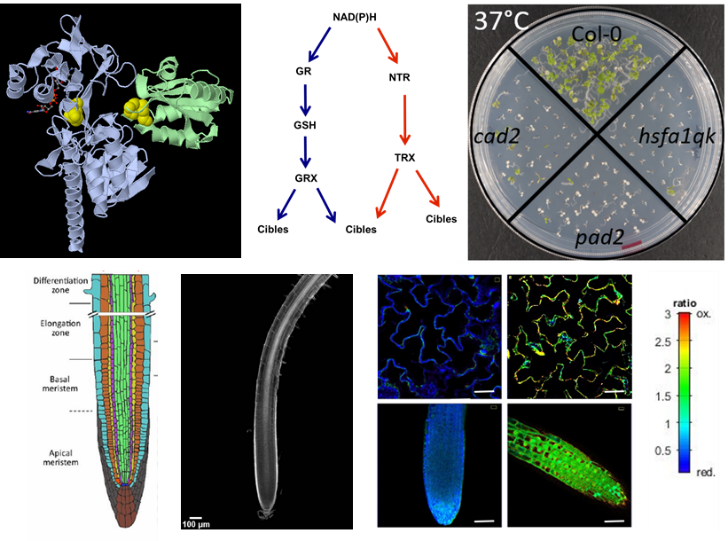Team PI : REICHHELD Jean-Philippe
Recent results from the ReDAC team: 
Research topics
Understanding the adaptation mechanisms of plants to environmental constraints is of major interest in the context of climate change. The redox modifications induced by reactive species of oxygen and nitrogen are important components of these mechanisms. Redox signaling occurs notably through post-translational modifications of the thiol residues of cysteines in many proteins. These modifications can be of different types (disulfide bonds, glutathionylation, nitrosylation, sulfenylation,...) and can alter the structure and activity of proteins, thereby influencing numerous functions. Thiol reduction systems such as glutathione and thiol reductases like glutaredoxins (GRX) and thioredoxins (TRX) play major roles in regulating the redox state of thiols. Our group has been studying these components for many years. These researches are mainly conducted in Arabidopsis thaliana through biochemical, genetic, and genomic approaches. Our work has contributed to the identification and classification of these proteins, and we have develop genetic and proteomic tools to characterize the biological functions and targets of these proteins. In particular, we have demonstrated the involvement of thiol reductants in various stages of plant development, hormonal signaling, carbon metabolism, and responses to environmental stresses.Recent results from the ReDAC team:
- Identification of thiol-reducing systems in the nuclear compartment (Marchal et al, 2014; Knuesting et al, 2015; Delorme-Hinoux et al, 2016).
- Highlighting the role of redox regulation of histone deacetylases (HDAC), involved in gene expression and chromatin remodeling under thermal stress conditions. ANR-REPHARE.
- Highlighting, in collaboration with the NoDS team, a redox regulation of RNAseIII type RTL1 and a possible role in the metabolism of siRNA (Charbonnel et al, 2017; Auverlot et al, 2023).
- Highlighting the functions of glutathione and glutaredoxin GRXS17 in the response to thermal stress through chaperone activity (Martins et al, 2020; Dard et al, 2023).
- Role of glutathione and type III glutaredoxins (ROXY) in root development and hormonal signaling (Trujillo-Hernandez et al, 2020; de la Fuente et al, 2024; El Baidouri et al, 2024). ANR-NIDROROX.

Illustration of the main approaches addressed in the ReDAC group.
We study the functions of the two main thiol reduction systems, thioredoxins and glutaredoxins, and the identification of some of their targets (top center). We use AI to model the location of regulatory cysteines within these proteins (top left). We investigate the role of these thiol reducers in responses to certain environmental stresses (e.g., thermal stress, top right) and on root development (bottom left). We also use redox-sensitive fluorescent markers to assess the effect of stress on the subcellular redox state (bottom right).
Keywords: Redox, Thiols, Thioredoxins, Glutaredoxins, Glutathione, Environmental stress, Root
Funded projects:
- ANR-NIDROROX (2025-2028)
- ANR-RoxRNase (2021-2025) Régulation redox de la réponse aux stress biotiques et abiotiques médiée par les petits ARNs
- ANR-REPHARE (2020-2025) Régulation redox de l'activité des HDAC de plantes en réponse au changement climatique
- Labex Agro-Projet Etendard CalClim (2020-2024)
Members
Past members
- Avilien Dard
- José Abraham Trujillo Hernández
Publication
- Articles
-
- Communications
-
- Thèse et HDR
-
Updated : July 1, 2025

